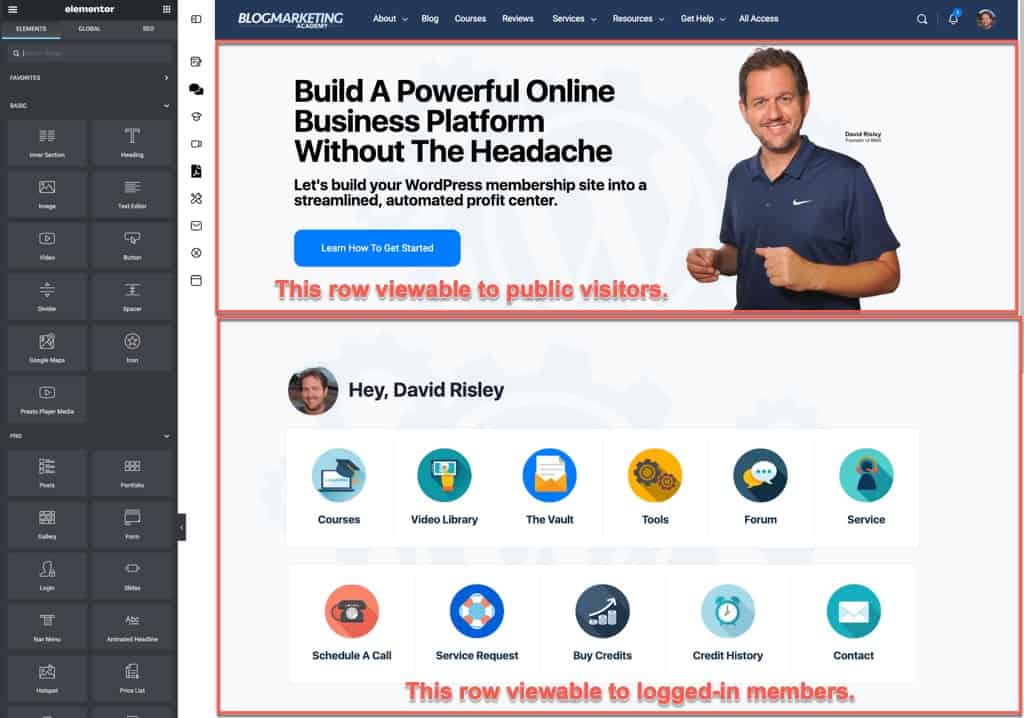
Very popular and capable page builder and theme builder for WordPress. Definitely a valuable purchase for visual control of your entire website.
My Rating:
Pros
- Highly capable page builder and theme builder
- Tons of integrations and third-party addons make Elementor highly flexible
- Can build your entire theme with Elementor
- Updated pretty often.
- Pro version is quite fairly priced.
Cons
- Does introduce a little bit of bloat to the site’s code
- The user interface does take a lot of clicks to find and do what you want. Not quite as quick as, say, Thrive Architect.
- Every now and then, updates will cause the site to look weird for a bit. It is rare, but could happen. Thankfully, it is easy to downgrade to previous version if needed.
Elementor is, perhaps, the most popular page builder for WordPress. There are, of course, other options such as Thrive Architect, Divi and Beaver Builder, but Elementor is extremely well-known, very well supported and has a wide community of add-ons and integrations.
Elementor does quite a bit. It isn’t just for building landing pages. Elementor is a site building tool. You can literally design your entire site with Elementor.
Some of the features include:
- Full visual page builder (obviously)
- Lots of pre-built templates
- Full theme builder to build your theme from scratch
- Ability to create popups
- Multiple built-in performance enhancements and optimizations
- Lots of third-party integrations
When you are editing anything, it works via your usual drag-and-drop builder interface. Your available tools are on the left side and you can just drag them into the page you are designing. It is very similar to Thrive Architect in that way, but decidedly different from the way Divi or Beaver Builder works.

Working and designing with Elementor is pretty easy, although like any such tool there would be a learning curve. Coming from Thrive Architect, I did find that Elementor required more clicks to do the same things. That said, it had more options. Over time, though, I’ve gotten quite used to the little quircks of how Elementor works and I’m pretty quick with it.
For me, the most compelling reason to use Elementor is all of the integrations. Not only do a lot of third-party plugins integrate with Elementor as built-in functions, but there are also third-party add-on plugins for Elementor that add additional tools you can use. In contrast, Thrive Architect does not have support for such third-party add-ons.
Some of the add-ons & integrations I personally use are:
- Ultimate Addons for Elementor
- FluentCRM has direct integration with Elementor forms.
- WP Fusion has integration to show/hide any page or theme element based on tags or logged-in status
- BuddyBoss is the theme I use and works very closely with Elementor to allow customization, including membership-specific templates you can use for BuddyBoss sites.
- Fluent Forms has a drag-and-drop widget where you can include the form on any page as well as customize it’s styling to a large degree.
Again, that was my initial draw to Elementor. I got tired of Thrive Architect being so unfriendly to integrations. Elementor was a breath of fresh air in that regard.
I have also been a fan of Thrive Theme Builder, from Thrive Themes. It works closely with Architect to give a full visual theme building platform. Well… Elementor Pro has that, too.

Not only can you use Elementor to override and customize certain aspects of pre-existing themes (like I do with BuddyBoss), but it also has a free starter theme called Hello Theme. Hello Theme is very barebones with the idea that you can turn it into anything you want using Elementor. You can even download and import what they call “Site Kits” to bring in full site designs as starting points for your website.
I personally find Thrive Theme Builder easier to use, however Elementor Pro has more capability and is more affordable as a theme building platform.
One thing I definitely want to mention is… bloat.
There is some concern about the size of Elementor and how it could slow down sites due to all of the code. To be clear, this is a valid concern as it would be with any page builder.
You could get around that by using a more streamlined tool such as a theme built for the block editor. I know those are an option, but personally I find the block editor tedious to use for real site designs. For me, the tools I use need to fit my working style and allow me to get the job done. A visual page builder like Elementor just works.
There are built-in performance enhancements inside Elementor that can optimize the code, the CSS and the like. You can also use performance plugins such as WP Rocket or PerfMatters. In the end, I find that performance with Elementor is completely fine. Sure, if you want to bleed out every little morsel of performance and spend your time getting that last few percentage points in your site speed scores, you can. But, frankly, your time is better spent on other things.
All in all, Elementor is a very capable page builder. And, frankly, a pretty good option to serve as your theme builder, too. It is priced pretty favorably as well. You can always download and use the base level Elementor for free, however all the goodies and the theme builder comes with the PRO version. It starts at $59/year and goes up depending on how many sites you want to use it on. I myself have an agency license and use it on a lot of client sites. It is quite handy for any developer.


